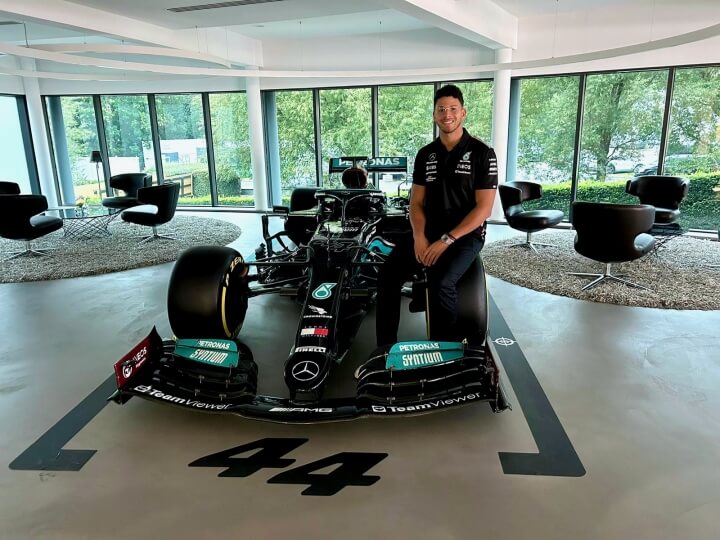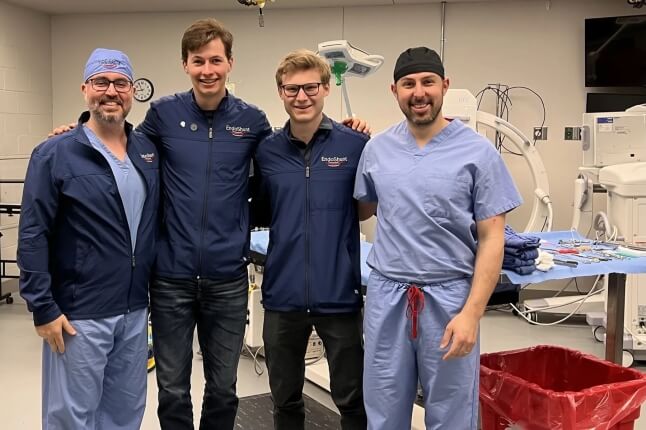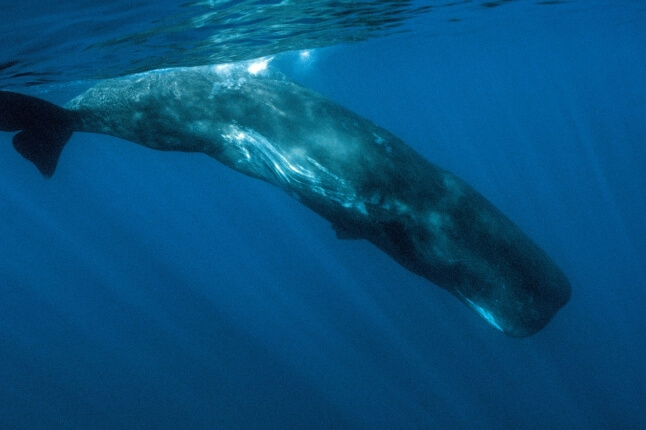News
Mechanical engineering concentrator Brice Austin is taking a gap year to work on the Race Strategy team for the Mercedes-AMG Petronas F1 team in the United Kingdom.
Brice Austin starts off his work day like many people. He goes into the office, says hi to his coworkers, then meets with his team. They analyze their previous work for mistakes and areas for improvement, then use those insights as they begin to plan their next project.
But Austin’s job is anything but routine. The mechanical engineering student currently taking a gap year from the Harvard John A. Paulson School of Engineering and Applied Sciences (SEAS) works at the Mercedes-AMG Petronas F1 team in the United Kingdom. His coworkers are people like Lewis Hamilton, a seven-time F1 world champion and one of the sport’s all-time greatest racers. The Race Strategy team that Austin is a part of is responsible for simulating upcoming F1 races and strategizing to achieve the highest finish possible.
“This is the coolest job I’ve ever had in my life,” Austin said. “It’ll be one of my proudest accomplishments.”
Tire management is critical to automotive racing. F1 cars routinely exceed speeds of 200 miles per hour, and no single set of tires can sustain speeds like that over a 305-kilometer race. As part of the Race Strategy team, Austin’s job involves simulating racing conditions, determining the best tires to use on a track and when to head into the pit for replacement. Austin’s team also uses simulation software to try to predict the tire management strategy for all the other racers and find the optimal times to go into the pit. The team prepares a strategy during the days leading up to a race, but also works during the race itself to adjust the strategy as needed depending on conditions.
We’re basically predicting every moment of the race. You’re always trying to be better, because this is a competition where you’re fighting for hundredths of a second. Doing anything we can to gain time anywhere in the process is part of the fun.
Austin grew up watching auto racing with his father in Michigan and developed a passion for the kind of hands-on mechanical engineering needed to build an elite race car. While he initially came to Harvard on a premed track, it wasn’t long before he wanted to return to his roots.
“I grew up on a farm in a really rural area, and I’ve worked with my hands my whole life,” Austin said. “I decided to go back to what I liked doing: building things and being creative.”
It didn’t take long for Austin to discover the Harvard Undergraduate Automotive Society and join its solar-powered vehicle team. Last summer, he did internships with Electric Last Mile Solutions and Our Next Energy, two companies in the electric vehicle space. But as much as all those experiences spoke to his passion for automotive engineering, nothing quite compares to the thrill of working for a professional F1 team.
Brice Austin, S.B. '25, in the SEC Makerspace (Annalee Durland-Jones, Above Summit)
“It’s definitely solidified that I want to do something a little more unique with my career,” he said. “What I’d like to do is be in an environment where I’m allowed to be creative and free-flowing and know I’m making a direct impact. When you know people are looking at your work and are reacting to it and value it, you want to do a better job.”
Also a member of the Harvard Crimson baseball team, Austin gets the same thrill on the racetrack as he does on the baseball diamond.
“For the race last weekend, I remember waking up thinking, ‘It’s game day!’” he said. “I had the pre-game nerves, so I think it’s very similar to baseball. This fills the space I’m not having because I’m not playing baseball right now, and it’s a really special experience to be able to compete.”
Austin doesn’t work on the cars themselves, so his internship relies more on data science than a direct translation of his mechanical engineering coursework. Instead, Austin most often finds himself using the problem-solving strategies he picked up at SEAS.
“What Harvard has emphasized is being able to think critically and come up with unique solutions,” he said.” It’s never been about making a specific robot, but rather the thinking process. My biggest skill here is being able to pick up things, analyze data, come to conclusions, and support them very quickly. It’s definitely a new world. I’ve had to pick up everything from scratch, but there was never a moment where I felt unqualified.”
When Austin returns to Harvard for his senior year next fall, he’s hoping to bring back the engineering and problem-solving skills he cultivated on the track, as well as rejoin the Automotive Society.
“There’s something so invaluable about working and practicing things outside of the classroom,” he said. “In the time that I’ve been here, I’ve learned things I never could’ve in my courses. This has allowed me to step back and really focus on what I think is important, which I’m super grateful for.”
Topics: Materials Science & Mechanical Engineering, Undergraduate Student Profile
Cutting-edge science delivered direct to your inbox.
Join the Harvard SEAS mailing list.
Press Contact
Matt Goisman | mgoisman@g.harvard.edu




